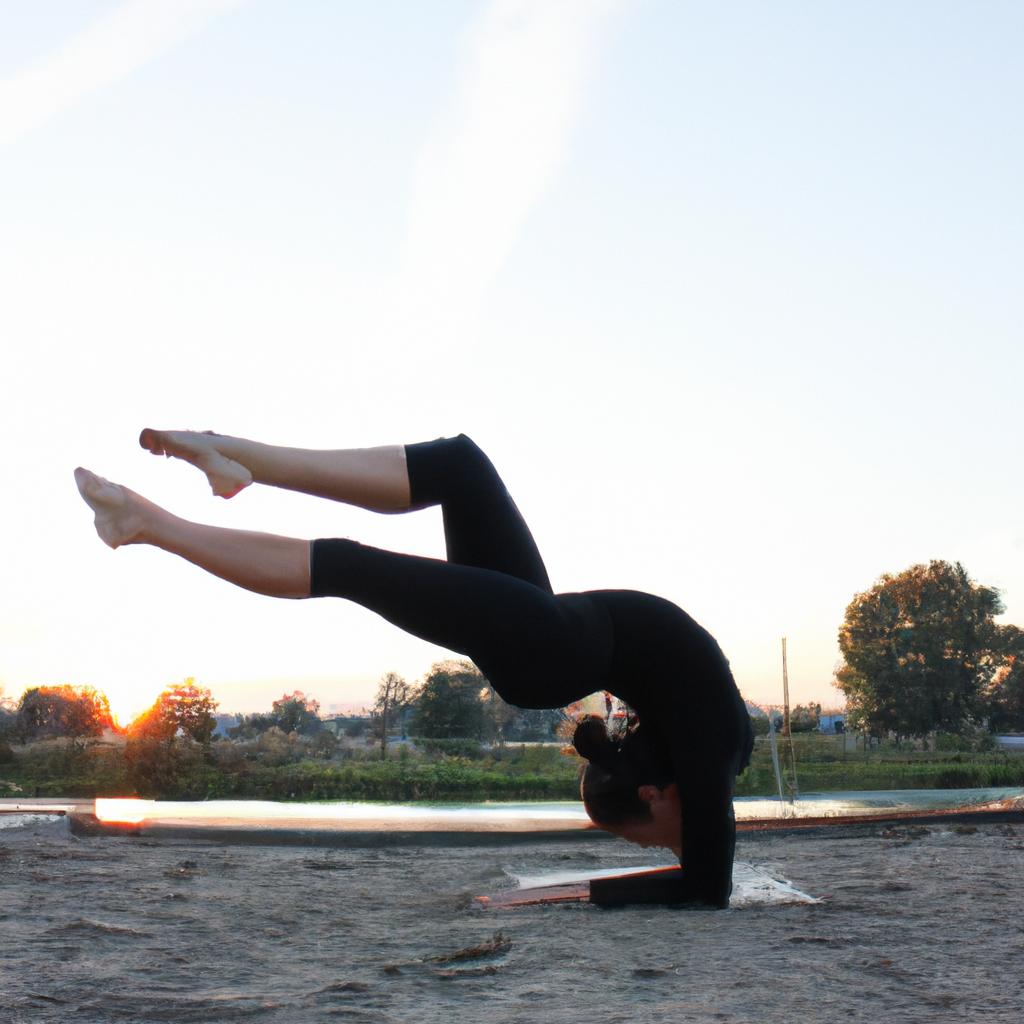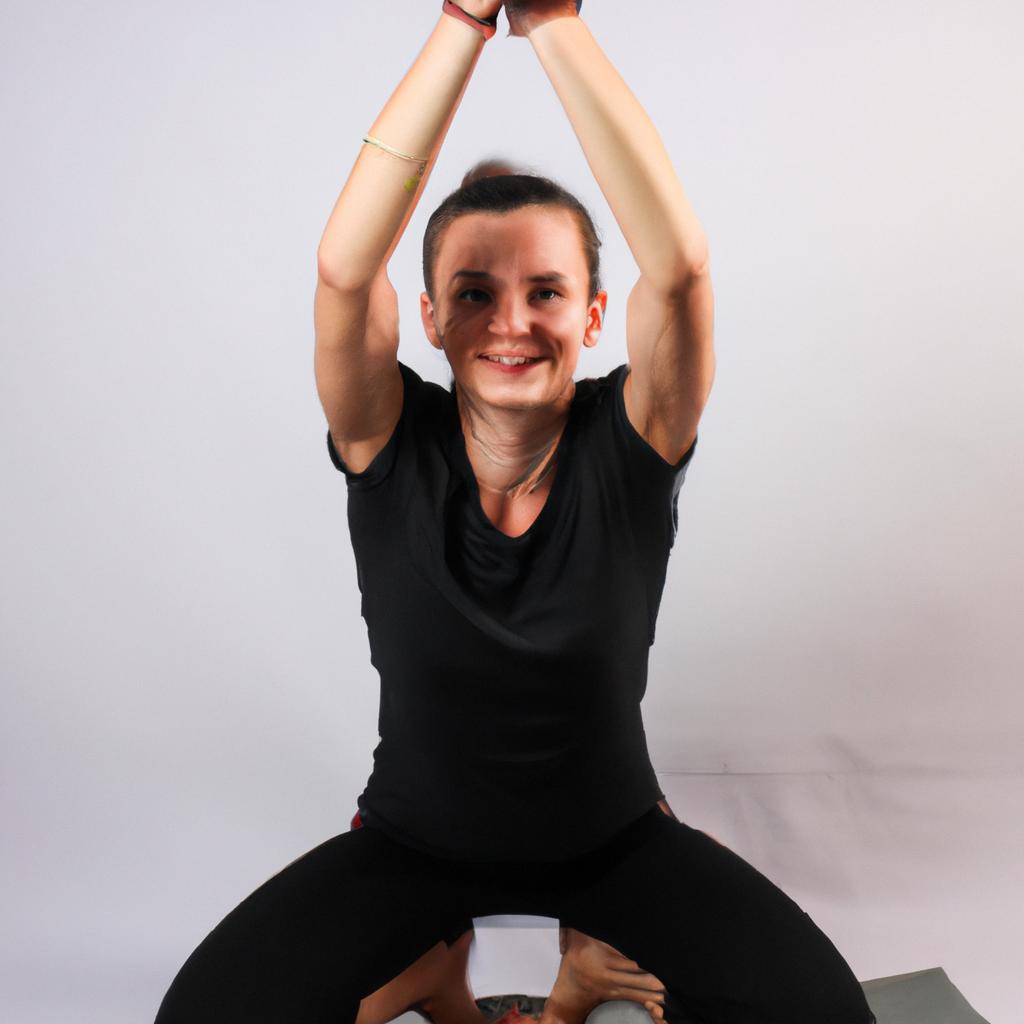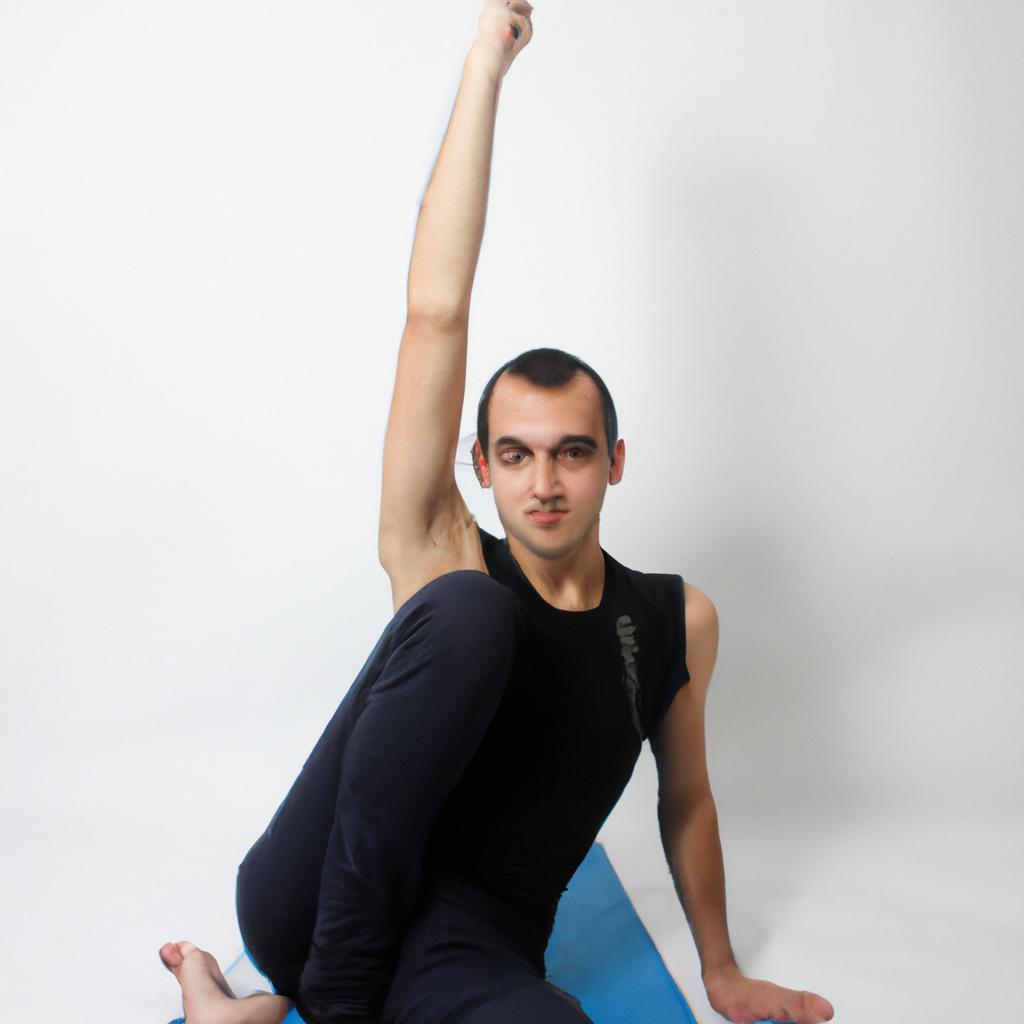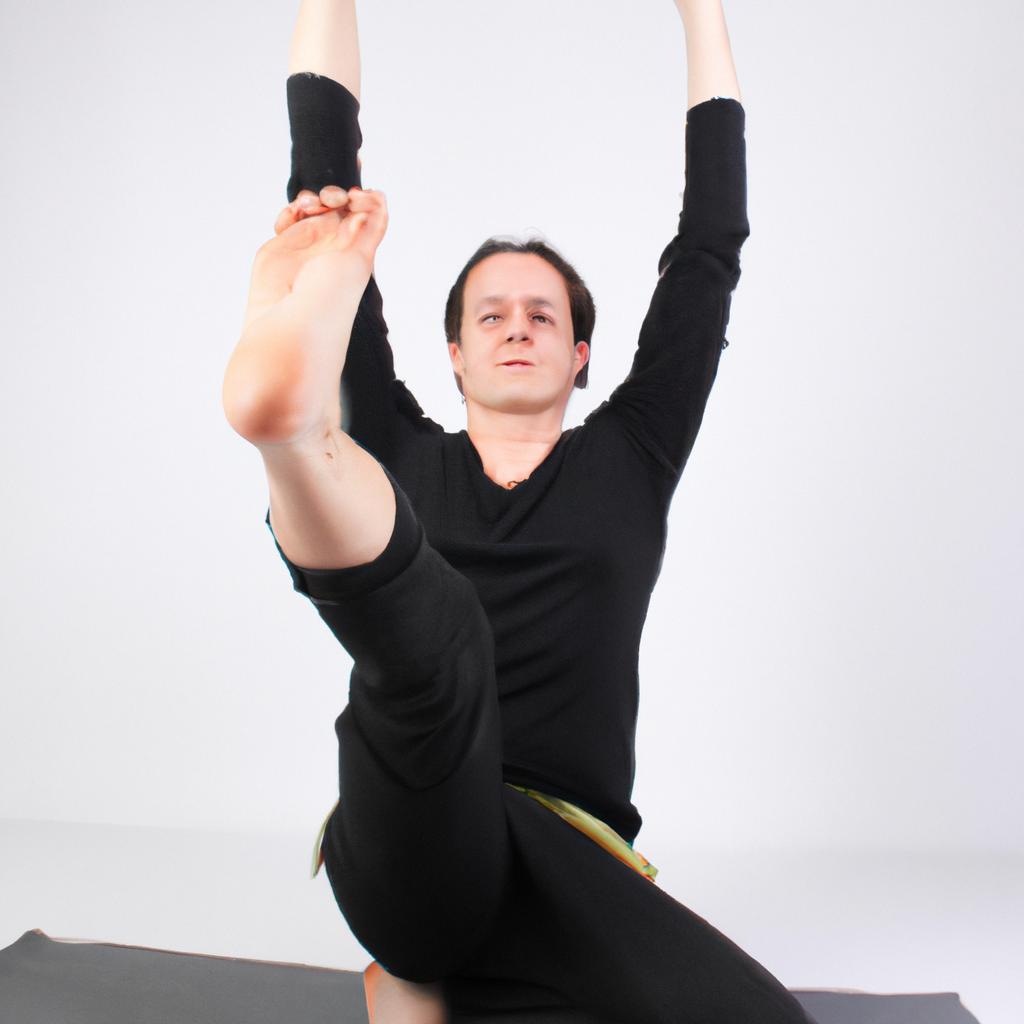In today’s fast-paced world, maintaining physical fitness has become a top priority for many individuals. Regular exercise is not only crucial for overall wellbeing but also plays a significant role in enhancing flexibility and mobility. Among various fitness practices, yoga stands out as an effective method to increase flexibility while simultaneously promoting strength and balance. For instance, imagine a hypothetical scenario where an individual who struggles with tight muscles and limited range of motion decides to incorporate regular yoga sessions into their fitness routine. Through consistent practice, they gradually begin to experience improvements in their flexibility, allowing them to perform daily activities with greater ease.
The art of yoga focuses on gentle movements combined with deep breathing techniques that help lengthen the muscles and improve joint range of motion. By stretching the body through various postures known as asanas, practitioners can target specific muscle groups and release tension accumulated from sedentary lifestyles or intense physical activity. Unlike other forms of exercise that primarily focus on building muscle mass or cardiovascular endurance, yoga places emphasis on creating space within the body by elongating tissues and increasing blood flow.
While it is true that everyone possesses varying levels of natural flexibility, engaging in regular yoga practice can lead to noticeable improvements regardless of one’s starting point. This article aims to explore how incorporating yoga into a fitness routine can lead to increased flexibility, as well as provide guidance on how to optimize yoga practice for maximum benefits.
Benefits of Yoga for Flexibility:
-
Lengthens Muscles: The gentle stretching and holding of yoga poses help lengthen muscles over time. As these muscles become more flexible, they allow for a wider range of motion in joints, resulting in improved overall flexibility.
-
Increases Joint Range of Motion: Yoga postures target specific joints and gradually increase their range of motion. By consistently practicing poses that focus on different areas of the body, such as hips, shoulders, or spine, individuals can experience significant improvements in joint mobility.
-
Releases Muscle Tension: Daily stressors and physical activities can create tension and tightness in the muscles. Yoga incorporates deep breathing techniques and relaxation exercises that promote muscle relaxation and release stored tension.
-
Improves Body Awareness: Through regular yoga practice, individuals develop a heightened sense of body awareness. This allows them to identify areas of stiffness or tightness within their bodies and work towards improving flexibility in those specific areas.
Optimizing Your Yoga Practice for Flexibility:
-
Consistency is Key: To see noticeable improvements in flexibility, it is essential to practice yoga consistently. Aim for at least two to three sessions per week to allow your body enough time to adapt and progress.
-
Warm-up before Yoga Sessions: Before diving into your yoga practice, warm up your body with dynamic movements like arm circles, leg swings, or light jogging. Warming up increases blood flow to the muscles and prepares them for deeper stretches during the yoga session.
-
Focus on Targeted Stretches: Incorporate specific poses that target areas where you want to improve flexibility. For example, if you are looking to increase hamstring flexibility, include forward folds like Uttanasana (Standing Forward Bend) or Paschimottanasana (Seated Forward Bend) into your practice.
-
Hold Poses and Breathe: While practicing yoga, hold each pose for a minimum of 30 seconds to a minute, allowing time for the muscles to lengthen and release tension. Focus on deep breathing during these poses to relax the body further.
-
Gradually Increase Intensity: As you progress in your yoga practice, gradually increase the intensity of your stretches by exploring more advanced variations or attempting new poses that challenge your flexibility. Always listen to your body and avoid pushing yourself too far beyond your limits.
Incorporating regular yoga practice into a fitness routine can lead to significant improvements in flexibility and joint range of motion. By focusing on gentle stretches, specific postures, and consistent practice, individuals can experience increased flexibility in various areas of their bodies. Remember to approach yoga with patience and mindfulness, embracing where you are in terms of flexibility while working towards improving it over time. With dedication and perseverance, the benefits of greater flexibility gained from yoga will enhance not only physical performance but also overall wellbeing.
Benefits of Incorporating Stretching Exercises
Imagine a scenario where an individual, let’s call her Sarah, has been struggling with muscle tightness and limited range of motion. She finds it challenging to perform daily tasks such as reaching for objects on high shelves or bending down to tie her shoes without experiencing discomfort or strain. This hypothetical example highlights the importance of incorporating stretching exercises into one’s fitness routine.
Stretching exercises offer numerous benefits that can enhance physical performance and overall well-being. Firstly, regular stretching helps improve flexibility by increasing the elasticity of muscles and tendons. This increased flexibility allows for a greater range of motion in joints, making everyday activities easier and reducing the risk of injuries during exercise or other physical activities.
In addition to improved flexibility, stretching exercises also promote better posture. Muscles that are tight and inflexible can pull the body out of alignment, leading to poor posture and potential musculoskeletal issues over time. By incorporating stretches that target specific muscle groups responsible for maintaining proper posture, individuals can correct imbalances and develop a more upright stance.
- Increased freedom of movement
- Enhanced athletic performance
- Reduced muscle soreness after workouts
- Improved relaxation and stress relief
Furthermore, implementing a variety of stretching exercises targeting different areas of the body provides a comprehensive approach towards achieving optimal flexibility. The table below outlines three key categories: upper body, lower body, and core stretches along with their corresponding benefits.
| Category | Stretches | Benefits |
|---|---|---|
| Upper Body | Shoulder stretch | Relieves tension in neck and shoulders |
| Chest opener | Improves breathing capacity | |
| Tricep stretch | Increases arm mobility | |
| Lower Body | Hamstring stretch | Enhances leg flexibility |
| Hip opener | Eases lower back pain and tightness | |
| Calf stretch | Reduces muscle cramps and stiffness | |
| Core | Spinal twist | Improves spinal mobility |
| Abdominal stretch | Strengthens core muscles | |
| Child’s pose | Relaxes the mind and body |
In conclusion, incorporating stretching exercises into a fitness routine brings a multitude of benefits such as increased flexibility, improved posture, reduced soreness, and enhanced relaxation. These advantages can greatly contribute to overall physical well-being and allow individuals to perform daily activities with greater ease.
Key Poses for Increasing Flexibility
Increasing flexibility is essential for individuals who engage in fitness studio practices, as it plays a significant role in preventing injuries and improving overall performance. By incorporating yoga into their routines, fitness enthusiasts can enhance their range of motion and achieve greater flexibility. Let’s delve deeper into the key poses that can help increase flexibility.
One example illustrating the positive impact of yoga on flexibility is Sarah, a regular attendee at her local fitness studio. Before she started practicing yoga, she struggled with tight muscles and limited mobility during her workouts. However, after consistently incorporating yoga into her routine, Sarah experienced significant improvements in her flexibility. She was able to perform exercises with greater ease and noticed increased muscle suppleness over time.
To further understand the benefits of incorporating stretching exercises like yoga, consider the following:
- Improved joint health: Yoga helps lubricate joints by increasing synovial fluid production, reducing stiffness and promoting better joint function.
- Enhanced posture: Regular practice of specific poses helps lengthen muscles and correct imbalances, leading to improved posture and reduced risk of musculoskeletal issues.
- Increased body awareness: Practicing yoga requires focus on breath control, alignment, and proper form. This mindfulness cultivates an enhanced understanding of one’s body and its limitations.
- Stress relief: The combination of physical movement, deep breathing techniques, and meditation involved in yoga aids in stress reduction and promotes relaxation.
| Pose | Targeted Muscle Groups | Benefits |
|---|---|---|
| Downward Dog | Hamstrings | Relieves tension in lower back |
| Cobra | Chest & Abdominals | Opens up chest for improved breathing |
| Pigeon | Hips & Glutes | Increases hip mobility |
| Standing Forward Fold | Calves & Hamstrings | Stretches entire posterior chain of muscles |
Incorporating these poses into a fitness studio practice can yield significant improvements in flexibility over time. By consistently engaging in yoga and focusing on proper alignment and breath control, individuals can gradually increase their range of motion.
Transitioning to the subsequent section about “How to Safely Warm Up Before Stretching,” it is crucial to prepare the body adequately before attempting any stretching exercises.
How to Safely Warm Up Before Stretching
Transition from Previous Section H2:
Having explored the key poses for increasing flexibility, it is now essential to focus on ensuring a safe and effective warm-up routine before engaging in stretching exercises. By implementing proper warming up techniques, individuals can reduce the risk of injury and enhance their overall performance during yoga sessions.
How to Safely Warm Up Before Stretching
To illustrate the importance of a suitable warm-up routine, let us consider an example where two individuals embark on a yoga practice session. One individual diligently performs a comprehensive warm-up, while the other skips this crucial step and jumps straight into stretching exercises. As they progress through their practice, the first individual experiences increased blood flow to their muscles, improved joint mobility, and heightened mental alertness due to enhanced neural activation. In contrast, the second individual may find themselves struggling with limited range of motion, decreased muscular power output, and potential strain or sprain injuries.
To ensure a productive warm-up that prepares the body for stretching exercises effectively, consider incorporating these recommended steps:
- Dynamic Movements: Begin with dynamic movements such as arm circles, hip rotations, or neck rolls to gradually increase heart rate and stimulate blood circulation.
- Cardiovascular Exercise: Engage in light cardiovascular activities like jogging in place or jumping jacks for several minutes to further elevate heart rate and promote oxygen delivery throughout the body.
- Joint Mobilization Exercises: Perform gentle stretches targeting major joints such as shoulders, hips, knees, and ankles to improve their range of motion.
- Pre-Stretch Activation: Incorporate pre-stretch activation exercises specific to the muscle groups involved in your upcoming yoga practice sequence. This will help prepare those muscles for deeper stretching later on.
Moreover, it is important to note that every individual’s warm-up routine may vary depending on factors such as fitness level and personal preferences. Tailoring your warm-up regimen based on guidelines provided by certified instructors or fitness professionals can further enhance the benefits derived from practicing yoga.
Implementing a structured warm-up routine reduces the risk of injury, enhances muscle performance and flexibility, and optimizes overall practice results. By dedicating time to properly prepare your body for stretching exercises, you set yourself up for a safe and rewarding experience throughout your fitness studio practices.
Transition into Subsequent Section about “Progressive Overload: Gradually Advancing Your Flexibility”:
Once an optimal warm-up has been completed, it is important to understand how progressive overload can be applied in order to gradually advance one’s flexibility. Through systematic adjustments in intensity, duration, or frequency of stretching exercises, individuals can effectively promote long-term improvements in their range of motion and overall flexibility.
Progressive Overload: Gradually Advancing Your Flexibility
Having learned about the importance of warming up before stretching, let us now explore the concept of progressive overload and how it can help you gradually advance your flexibility.
To illustrate the effectiveness of progressive overload in enhancing flexibility, consider the case study of Sarah. Sarah has been practicing yoga for several months and wants to improve her ability to perform advanced poses such as the splits. Initially, she could only reach halfway down when attempting a split. However, by implementing progressive overload techniques into her practice, she was able to steadily progress and eventually achieve a full split.
Progressive overload involves consistently challenging your muscles beyond their current capacity over time. By gradually increasing the intensity, duration, or difficulty of your stretches, you stimulate your body to adapt and become more flexible. Here are some strategies you can incorporate into your routine:
- Stretching Duration: Increase the amount of time you hold each stretch by 10-20 seconds every week.
- Range of Motion: Slowly push yourself further into each stretch without causing pain or discomfort.
- Resistance Training: Utilize resistance bands or weights during certain stretching exercises to add resistance and deepen the stretch.
- Frequency: Perform stretching sessions more frequently throughout the week to provide consistent stimulus for improvement.
| Factors Affecting Flexibility | Examples |
|---|---|
| Genetics | Natural range of motion inherited from parents |
| Age | Typically reduced flexibility with aging |
| Gender | Women generally have greater natural flexibility than men |
| Physical Activity | Regular exercise promotes increased joint mobility |
As we continue our journey toward enhanced flexibility through yoga practices, understanding progressive overload is a crucial step. By gradually pushing our bodies beyond their current limits, we can achieve greater flexibility and unlock new possibilities in our practice.
Now that you have gained insight into the concept of progressive overload, let us explore recommended yoga props for enhancing flexibility.
Recommended Yoga Props for Enhancing Flexibility
Imagine a yoga practitioner named Sarah who has been practicing for several months and now wants to take her flexibility to the next level. In order to continue making progress, she needs to implement a principle known as progressive overload into her yoga routine. Progressive overload involves gradually increasing the demands placed on the body in order to stimulate further adaptation and improvement.
Implementing Progressive Overload: Key Strategies
To effectively advance your flexibility through progressive overload, consider incorporating the following strategies:
- Increase range of motion: Encourage your joints to move through a greater range by deepening your stretches gradually over time. For example, if you can comfortably reach down and touch your toes, try aiming for the floor instead.
- Incorporate longer holds: Extend the duration of each stretch or pose you practice. By holding these positions for an extended period, such as 1-2 minutes, you give your muscles ample time to adapt and lengthen.
- Use additional resistance: Introduce props like straps or blocks during stretching exercises to add resistance and challenge your muscles further. These tools can help you go beyond your current limits while maintaining proper form.
- Explore more advanced poses: As you become comfortable with basic poses, start exploring more challenging variations that target specific muscle groups or increase overall flexibility.
Emotional Response – Bullet Point List
Implementing progressive overload may evoke various emotions throughout your fitness journey:
- Excitement as you witness improvements in your flexibility
- Frustration when progress seems slow or plateaus are encountered
- Satisfaction from pushing yourself outside your comfort zone
- Motivation to keep striving for increased mobility and agility
Emotional Response – Table
| Emotion | Description | Ways to address |
|---|---|---|
| Excitement | A positive emotion felt when experiencing progress in flexibility | Celebrate small victories, set short-term goals |
| Frustration | A negative emotion that arises when progress is slow or halts | Break down long-term goals into smaller achievable milestones |
| Satisfaction | A feeling of contentment and fulfillment from pushing beyond your limits | Acknowledge personal growth, reward yourself for achievements |
| Motivation | The drive to continue working towards increased mobility and agility | Seek support from like-minded individuals, track progress regularly |
By implementing these strategies and acknowledging the emotional responses associated with progressive overload in flexibility training, you can navigate your fitness journey more effectively.
Transition: Combining Yoga with Other Fitness Practices for Optimal Flexibility
Transitioning from recommended yoga props, let us now explore the benefits of combining yoga with other fitness practices for optimal flexibility. This integration allows individuals to experience a holistic approach to improving their flexibility while diversifying their workout routine. To illustrate this concept, imagine a dedicated individual named Sarah who regularly attends a fitness studio that offers both yoga and strength training classes.
By incorporating yoga into her fitness regimen, Sarah not only enhances her flexibility but also gains numerous physical and mental benefits. Combining yoga with other exercises provides an opportunity for cross-training, enabling different muscle groups to be targeted and developed. For instance, the dynamic movements in a power vinyasa flow class can complement strength training by increasing joint mobility and range of motion. Additionally, practicing inversions like headstands or handstands improves balance and core stability, which are essential for various activities such as weightlifting or gymnastics.
- Increased Mind-Body Connection: Engaging in mindful movement through yoga cultivates self-awareness and helps individuals connect deeply with their bodies.
- Reduced Risk of Injury: Enhanced flexibility obtained from regular yoga practice can minimize the risk of injuries during high-intensity workouts or sports activities.
- Enhanced Recovery: Incorporating gentle stretching sequences from yoga post-workout promotes muscle recovery and reduces stiffness.
- Stress Reduction: The combination of physical exercise and focused breathing techniques in yoga aids in stress reduction and overall well-being.
In addition to these benefits, it is noteworthy to mention how varying combinations of yoga styles can have diverse effects on one’s flexibility levels. The table below showcases three popular forms of yoga along with their specific impact on enhancing flexibility:
| Yoga Style | Description | Flexibility Focus |
|---|---|---|
| Vinyasa Flow | Dynamic, flowing sequences with a focus on breath | Full-body flexibility improvement |
| Yin Yoga | Slow-paced practice targeting deep connective tissues | Increased joint mobility and passive stretching |
| Ashtanga Yoga | Fast-paced series of postures emphasizing strength | Enhanced muscular endurance and active stretching |
By integrating yoga classes that emphasize different styles into her fitness routine, Sarah can enjoy a well-rounded approach to enhancing her flexibility. This combination not only promotes physical growth but also fosters mental clarity and overall wellness.
In summary, by incorporating various forms of yoga alongside other fitness practices, individuals like Sarah can optimize their flexibility training while reaping the benefits of cross-training. The integration allows for targeted muscle development, increased mind-body connection, reduced injury risk, enhanced recovery, stress reduction, and varied approaches to improving flexibility based on specific yoga styles. So why limit oneself to a single exercise modality when one can experience the synergistic effects of combining yoga with other fitness practices?




